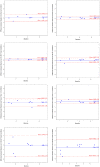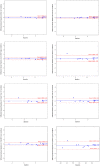Stability of novel urinary biomarkers used for lupus nephritis
- PMID: 35967565
- PMCID: PMC9372620
- DOI: 10.3389/fped.2022.974049
Stability of novel urinary biomarkers used for lupus nephritis
Abstract
Background: The Renal Activity Index for Lupus (RAIL) is a composite score of six urinary biomarkers (neutrophil gelatinase-associated lipocalin (NGAL), monocyte chemoattractant protein-1 (MCP-1), kidney injury molecule-1 (KIM-1), ceruloplasmin, adiponectin, and hemopexin) used to monitor lupus nephritis activity in children. We tested stability of RAIL biomarkers prior to meaningful clinical use.
Methods: Urine samples were tested by ELISA under shipping conditions, freeze/thaw, ambient and longer-term storage. Statistical analysis was performed via Deming Regression, Bland-Altman and Spearman Correlation Coefficient.
Results: Biomarker concentration were comparable to freshly collected urine following storage at -80 °C for up to 3 months, and at 4 or 25 °C up to 48 h followed by -80 °C. Neither shipping on dry or wet ice exposure nor addition of two freeze-thaw cycles led to loss of signal, with excellent Spearman Correlation coefficients under all conditions.
Conclusions: RAIL biomarkers are stable following short-term storage at clinically relevant conditions.
Keywords: SLE; biomarker; lupus nephritis; stability; urine.
Copyright © 2022 Cody, Rose, Huang, Qiu, Brunner and Devarajan.
Conflict of interest statement
Author PD is a co-inventor on submitted patents for the use of NGAL as a biomarker of kidney disease. The remaining authors declare that the research was conducted in the absence of any commercial or financial relationships that could be construed as a potential conflict of interest.
Figures





Similar articles
-
Effects of age and gender on reference levels of biomarkers comprising the pediatric Renal Activity Index for Lupus Nephritis (p-RAIL).Pediatr Rheumatol Online J. 2017 Oct 13;15(1):74. doi: 10.1186/s12969-017-0202-0. Pediatr Rheumatol Online J. 2017. PMID: 29029629 Free PMC article.
-
Successful Urine Multiplex Bead Assay to Measure Lupus Nephritis Activity.Kidney Int Rep. 2021 Apr 28;6(7):1949-1960. doi: 10.1016/j.ekir.2021.04.016. eCollection 2021 Jul. Kidney Int Rep. 2021. PMID: 34307989 Free PMC article.
-
Prospective validation of a novel renal activity index of lupus nephritis.Lupus. 2017 Aug;26(9):927-936. doi: 10.1177/0961203316684212. Epub 2016 Dec 19. Lupus. 2017. PMID: 28361601 Free PMC article.
-
The novel role of neutrophil gelatinase-B associated lipocalin (NGAL)/Lipocalin-2 as a biomarker for lupus nephritis.Autoimmun Rev. 2008 Jan;7(3):229-34. doi: 10.1016/j.autrev.2007.11.013. Epub 2007 Dec 3. Autoimmun Rev. 2008. PMID: 18190883 Review.
-
Diagnostic, predictive and prognostic biomarkers in systemic lupus erythematosus: current insights.Curr Opin Rheumatol. 2022 Mar 1;34(2):139-149. doi: 10.1097/BOR.0000000000000862. Curr Opin Rheumatol. 2022. PMID: 35013077 Review.
Cited by
-
Longitudinal assessment of urinary ALCAM, HPX, and PRDX6 in Korean patients with systemic lupus erythematosus: implications for disease activity monitoring and treatment response.Front Immunol. 2024 Jun 10;15:1369385. doi: 10.3389/fimmu.2024.1369385. eCollection 2024. Front Immunol. 2024. PMID: 38915417 Free PMC article.
-
Development and Validation of Multiplex Assays for Lupus Nephritis Activity Biomarkers.Kidney Int Rep. 2025 Apr 21;10(7):2255-2264. doi: 10.1016/j.ekir.2025.04.013. eCollection 2025 Jul. Kidney Int Rep. 2025. PMID: 40677325 Free PMC article.
-
Biomarkers Associated with Drugs for the Treatment of Lupus Nephritis.Biomolecules. 2023 Oct 31;13(11):1601. doi: 10.3390/biom13111601. Biomolecules. 2023. PMID: 38002282 Free PMC article. Review.
-
Role of MCP-1 as an inflammatory biomarker in nephropathy.Front Immunol. 2024 Jan 4;14:1303076. doi: 10.3389/fimmu.2023.1303076. eCollection 2023. Front Immunol. 2024. PMID: 38239353 Free PMC article. Review.
References
Grants and funding
LinkOut - more resources
Full Text Sources
Research Materials
Miscellaneous

